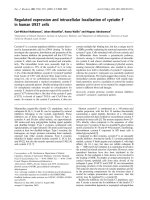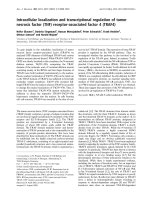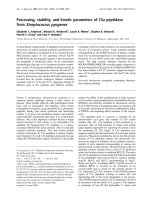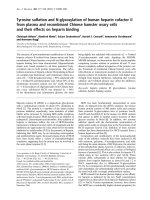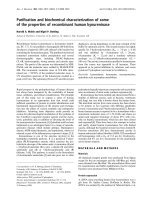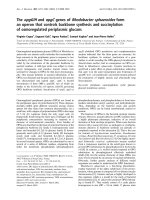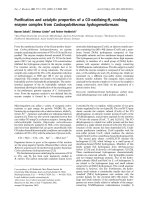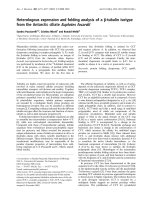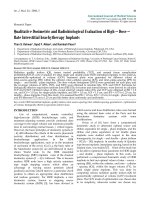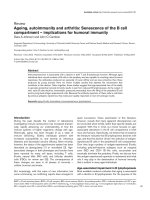Báo cáo y học: "Marked disability and high use of nonsteroidal antiinflammatory drugs associated with knee osteoarthritis in rural China: a cross-sectional population-based survey" ppt
Bạn đang xem bản rút gọn của tài liệu. Xem và tải ngay bản đầy đủ của tài liệu tại đây (339 KB, 7 trang )
RESEARC H ARTIC LE Open Access
Marked disability and high use of nonsteroidal
antiinflammatory drugs associated with knee
osteoarthritis in rural China: a cross-sectional
population-based survey
Jianhao Ling
1
, Marlene Fransen
2*
, Xiaozheng Kang
3
,HuLi
1
, Yan Ke
1
, Zhiqiang Wang
1
, Yuqing Zhang
4
, Steve Su
5
Abstract
Introduction: The burden of disability, analgesia, and health services use associated with knee pain and
osteoarthritis (OA) in developing countries is relatively unknown, despite a high proportion of these populations
required to be engaged in heavy occupational physical activity throughout their life span. The aim of this survey
was to estimate the burden of disability, analgesia, and health services use associated with knee pain in rural
China.
Methods: This was a population-based cross-secti onal survey among residents, aged 50 years and older, of
Wuchuan County, Inner Mongolia. Participants completed an interviewer-based questionnaire, evaluating knee pain
and associated disability, analgesia, and health services use, and obtained bilateral standardized weight-bearing
knee ra diographs.
Results: Of the 1,027 participant s, 513 (50%) reported knee pain on most days of at least 1 month in the past year,
with 109 (21%) also demonstrating radiographic OA (Kellgren-Lawrence grade ≥2) in the symptomatic knee.
Adjusting for age, gender, body mass index (BMI), education, and back pain, the presence of knee pain was
associated with significantly greater difficulty in walking, climbing 10 steps, stooping, completing cleaning chores,
and preparing meals. Among the 513 subjects with knee pain, the additional presence of radiographic evidence of
OA was significantly associate d with more occasions of “unbearable” pain (59% versus 36%) and restricted activity
(64% versus 39%), as well as increased use of nonsteroidal antiinflammatory drugs (NSAIDs) (88% versus 78%) and
the reported number of doctor visits (59% versus 33%) in the past year. The use of paracetamol for knee pain was
rare (6% versus 2%).
Conclusions: Knee pain is highly prevalent in rural northern China. The associated significa nt disability and marked
preferential use of NSAIDs as analgesia should be of concern in these communities reliant on heavy occupational
physical activity for their livelihood. The findings will be useful to guide the distribution of future health care
resources and preventive strategies. A similar article has been published in the Chinese language journal, National
Medical Journal of China.
Introduction
Knee pain due to osteoarthritis (OA) is considered a
highly prevalent disease among older persons [1-4].
However, most large population-based observational
studies evaluating OA disease prevalence have been con-
ducted in North Ameri ca or Europe although it has
been estimated that by 2050, almost four fifths of the
world’s older population (65 years and older) will be li v-
ing in less-developed regions o f the world [5]. To start
to address this disparity, the WHO-APLAR COPCORD
collaboration conducted a series of observational studies
evaluating the prevalence of rheumatologic diseases in
* Correspondence:
2
Faculty of Health Sciences, University of Sydney, East Street, Lidcombe 1825,
Australia
Full list of author information is available at the end of the article
Ling et al. Arthritis Research & Therapy 2010, 12:R225
/>© 2010 Fransen et al.; licensee BioMed C entral Ltd. This is an open access article distributed under the terms of the Creative Commons
Attribution License (htt p://creativecommons.org/licenses/by/2.0), which permits unrestricted use, distribution, and reproduction in
any medium, pro vided the original work is properly cited.
several Asian populations [6-12]. However, whereas
these studies provided estimates of region-specific OA
disease prevalence, these could not be compared with
prevalence reported from North America or Europe
because of the lack of standardization in disease defini-
tion. Further, these stud ies provided little informat ion
on associated disability or medication and health ser-
vices use.
A recent population-based survey conducted in a rural
area in Northern China (Wuchuan, Inner Mongolia)
[13] and using a standardized definition of knee pain
and knee radiographs provided initial evidence that knee
OA prevalence or disease presentation observed in
North America or Europe may not be directly extrapo-
lated to rural communities in less-developed regions of
the world. The prevalence of sy mptomati c knee OA in
Wuchuan County was significantly higher compared
with age- and gender-compatible peers in Framingham,
Massachusetts, North America[13].Further,although
the prevalence of radiographic knee OA found in rural
Wuchuan County was similar t o that demonstrated in
Beijing, the prevalence of symptomatic knee OA was
significantly higher in the rural compared with the
urban community [13].
Although simple region-specific disease-prevalence
estimates are important, associated symptom severity
(pain, disability) and use of treatments and health ser-
vices will determine the actual disease burden. The indi-
vidual O A disease b urden demonstrated in high-income
countries or among urban cohorts with mostly sedentary
occupations cannot be d irectly extrapolated to less-
developed countries or rural communities. Region-specific
information will be required to guide the distribution of
future health care resources and preventive strategies.
The aim of this study was to describe and compare
levels of pain, physical disability, and use of medications
and health services among people with knee pain and
symptomatic knee OA with those of their unaffected
peers among older people living in Wuchuan County, a
rural region in Northern China.
Materials and methods
The sampling methods of this survey among people
aged 50 years and older living in Wuchuan County,
Inner Mongolia, have been detailed elsewhere [13]. In
brief, within five randomly selected communities, a
compact segment-sampling method was used to identify
clusters, each containing six to eight villages. Clusters
were then selected with a probability proportional to the
population size at the last census. Then a sketch map
was drawn of each selected cluster (total, 30), showing
the dwellings present. The selected clusters were each
spl it into a small number of segments (two to four seg-
ments), such that the number of dwellings per segment
was always roughly the same (20 to 30 h ouseholds).
One segment was then chosen at random from each
cluster, and all households in the segment were included
in the survey. Specific ethnic groups were neither tar-
geted nor excluded. Ethnicity was further not recorded
in this survey, as the cohor t was almost exclusively Han
Chinese (> 99%).
The study was approved by t he Peking University
Health Science Center Ethics Committee, and informed
consent was obtained from all study participants accord-
ing to the Declaration of Helsinki.
Participants
Trained health professionals administered the survey
questionnaires, as it was anticipated that many study par-
ticipants would be illiterate. All interviewers, clinical
examiners, and x-ray technicians were trained under the
supervision of the study chief investigators (XK, JL).
Trained interviewers went door-to-door to enumerate
and interview all men and women, aged 50 years or
older, within the selected households who were self-
described residents of Wuchuan County. Individuals who
self-reported rheumatoid arthritis, cerebrovascular dis-
ease, or a history of lower-limb surgery were excluded
from further participation, as it would be difficult to iso-
late the pain and disability burden due to knee osteoar-
thritis from that attributab le to cerebrovascular disease,
rheumatoid arthritis, or prior lower-limb surgery.
Subjects were interviewed at their homes or work
places. At the end of the interview, all study participants
were invited to one central examination site at
Wuchuan Hospital for a clinical examination and knee
radiographs on the same day. Transportation to the hos-
pital was provided.
After the collection of basic demographic data, all sur-
vey participants were asked to respond to the Medical
Outcome Study Short Form (SF-12) standard question-
naire (validated Chinese language version) evaluating
health-related quality of life. The S F-12 questionnaire is
well validated for use among patients with OA [14]. To
increase precision and reduce the number of statistical
comparisons needed, algorithms were dev eloped from
the eight health domains assesse d, to calculate two sum-
mary measures: the Physical Component Summary Scale
Score (PCS) and the Mental Component Summary Scale
Score (MCS) [14].
Survey participants further reported the level of diffi-
culty (that is, n o difficulty, some difficulty, much diffi-
culty, unable to do, don’ tknow,ordon’ tdo)when
performing the following specific activities: walking for
two li (approximately 1 kilometer); walking up 10 steps
without resting, stooping, crouching, or kneeling; clean-
ing chores around the house like f olding quilts, sweep-
ing, dusting, or straightening up; or preparing meals.
Ling et al. Arthritis Research & Therapy 2010, 12:R225
/>Page 2 of 7
Subjects who reported having had pain, aching, or
stiffness lasting at least a month in or around the knee
in the past 12 months were further asked (In the past
12 months): How severe was the pain usually? (usually
bearable, sometimes unbearable, mostly or always
unbearable); Have you limited your daily activiti es, such
as required by your job or housework, because of pain,
aching, or stiffness in your knee? (No, Yes).
Subjects who reported knee pain were asked if they
had received any of the following treatments in the past
12 months for their knee pain: herbal medicine,
acupuncture, massage, other traditional Chinese medicine,
nonsteroidal antiinflammatory drugs (including diclofenac
(voltaren), fenbid, ibuprofen, sulindac (clinoril), naproxen
(naprosyn), indomethacin suppository), paracetamol/
acetaminophen/Tylenol, physiotherapy, or surgery.
These participants were also asked if they had seen a doc-
tor in the past 12 months for knee pain, aching, stiffness,
or arthritis.
Clinical examination and knee radiograph
Height was measured with a wall-mounted stadiometer,
by using the ave rage of two measurements taken. Body
weight was assessed by using a balance-beam scale with
0.1-kg precision. A posterio r-anterior weight-bearing
semiflexed radiograph was taken of both knees strictly
according to a validated acquisition protocol [15].
Radiographs were read by the study chief investigator
(XK), and Kellgren-Lawrence grades (0 to4) were
ass igned. The reading metho ds of this survey have been
detailed elsewhere [13].
Knee pain was defined as having a positive response to
the question, “In the past 12 months, have you had knee
pain lasting most days of at least a month?” Sympto-
matic knee OA was defined as having knee pain and
scoring a Kellgren-Lawrence grade ≥2 in the radiograph
of this knee.
Statistical analysis
We divided participants into three groups:
1) subjects with no knee pain in the past 12 months;
2) subjects with knee pain in at least one knee in the
past 12 months, but without radiographic OA (Kellgren-
Lawrence grade <2) in a symptomatic knee; and
3) subjects with knee pain in at least one knee in the
past 12 months and with radiographic OA (Kellgren-
Lawrence grade ≥2) in the symptomatic knee.
By using an analysis of variance for continuous vari-
ables and a c
2
test for categoric variables, we compared
sociodemographic character istics of the three groups of
participan ts. We examined the relation of knee pain and
symptomatic knee OA to the prevalence of various mea-
sures of physical di sability with multivariable logistic
regression models. In the regression models, we adjusted
for age, gender, BMI, presence of back pain, and years
of education. Among those with knee pain, we evaluated
the association of radiographic knee OA and use of
health services and medications by using the multivari-
able logistic regression model. All the analyses were per-
formed by usi ng R-2.6.1, a statistical program developed
by the R Foundation for Statistical Computing, Vienna,
Austria [16].
Results
In total, 1,165 individuals aged 50 years and older were
identified in the randomly selected households in
Wuchuan County, Inner Mongolia (Figure 1).
Wuchuan OA Study
Sample population and exclusions
Of these, 27 subjects were excluded from further study
participation (rheumatoid arthritis (n = 7), cerebrovascu-
lar disease (n = 11), or a history of lower-limb surgery
(n = 9)). Of the rem aining 1,138 residents approached,
1,030 (91%) consented to participate in the study and
completed the home interview during the months of
October and November 2005. People declining to
consent were mostly older compared with the study
participants (mean (SD) 64 (7) versus 58 (8) years,
respectively). O nly three consenting participants did not
attend the radiographic examination.
Of the 1,027 participants with knee radiographs, 513
(50%) reported having knee pain in the past 12 months.
Of these participants with knee pain, 109 (21%) had radio-
graphic disease (Kellgren-Lawrence grade ≥2) in the symp-
tomatic knee. At the time of data analysis, it was
discovered that 24 men and 26 women were actually
younger than 50 years (48 or 49 years), and two partici-
pants had a history of minor knee surgery. As the age
Figure 1 Wuchuan County Osteoarthritis Study. Recruitment.
Ling et al. Arthritis Research & Therapy 2010, 12:R225
/>Page 3 of 7
difference or surgery was minimal, it was decided to retain
these data in the analysis. The mean body mass index
(BMI) of all survey participants was 22 kg/m
2
,withonly
63 (6%) considered to be obese (BMI ≥28) and 219 (21%)
considered overweight (BMI ≥24, but less than 28) accord-
ing to specific Asian population criteria [17].
The characteristics of the t hree groups of participants
are presented in Table 1. Significant differences were
found in age, gender, BMI, presenc e of back pain, and
years of education between the three groups. Partici-
pants with symptomatic knee OA (defined as the combi-
nation of knee pain and radiographic OA in the
symptomatic kne e) were slightly older, had a higher
mean BMI, and were more likely to be women, com-
pared with those without radiographic disease. The pre-
valence of back pain was higher in participants with
knee pain (without or without radiographic disease)
compared with participants without knee pain, but simi-
lar between the two categories of par ticipants with knee
pain. The majority of participants received less than
7 years of formal education. Almost all participants
were farmers or had been engaged in farming as their
main occupation, and most participants were still work-
ing. No significant differences were noted in the SF-12
PCS between the three groups, but persons with knee
OA had a small but significantly higher SF-12 MCS
compared with those without knee pain.
The results presen ted in Table 2 demonstrate that
participants with knee pain were 2 to 4 times more
likely to experience difficulty with usual daily activities
compared with participants without knee pain, even
when the analysis was adjusted for age , gender, BMI,
presence of back pain, and years of formal education.
These difficulties were even more likely to be present in
established radiographic knee OA. The increased odds
among people with symptomatic knee OA, compared
with participants with knee pain only, was significant
for walking for 2 li and “ stooping, crouching, or
kneeling.”
A 99% to 100% response rate occurred to each of the
questions regarding medications and health s ervices use
in the past 12 months (Table 3), apart from the question
regarding the use of “other Western medicine,” to which
11% and 23% of participants with knee pain and knee
Table 1 Characteristics of the Wuchuan County OA Study participants
No knee pain
(n = 514)
Knee pain
(n = 404)
Symptomatic knee OA
a
(n = 109)
P
Age, years; mean (SD) 57.3 (7.8) 56.2 (7.4) 62.7 (8.9) < 0.001
Female 45% 54% 68% < 0.001
BMI (kg/m
2
), mean (SD) 22.0 (3.1) 22.5 (3.1) 24.0 (4.0) < 0.001
Back pain 29% 51% 43% < 0.001
< 7 years’ education 74% 72% 84% 0.04
Occupation, farming 93% 90% 83% 0.002
Still working 86% 89% 67% < 0.001
SF-12 PCS, mean (SD) 49.9 (6.2) 49.9 (6.8) 49.3 (6.8) 0.7
SF-12 MCS, mean (SD) 52.3 (6.1) 53.4 (5.7) 54.6 (7.1) 0.004
a
Radiographic OA in a painful knee. MCS, Mental Component Summary Score; PCS, Physical Component Summary Score.
Table 2 Self-reported physical disability
Outcome n “With
difficulty”
a
OR (95% CI)
[P]
b
Walk for 2 li (1 km)
No knee pain 514 22% 1
Knee pain 402 37% 1.9 (1.4 to 2.7)
Knee OA 109 60% 3.2 (2.0 to 5.2)
[P = 0.04]
Up 10 steps without resting
No knee pain 491 30% 1
Knee pain 387 64% 4.0 (3.0 to 5.5)
Knee OA 104 78% 5.5 (3.3 to 9.8)
[P = 0.27]
Stooping, crouching,
kneeling
No knee pain 514 33% 1
Knee pain 404 70% 4.2 (3.1 to 5.8)
Knee OA 109 90% 14.5 (7.5 to
31.0)
[P < 0.001]
House-cleaning chores
No knee pain 514 7% 1
Knee pain 404 14% 1.8 (1.1 to 2.8)
Knee OA 109 25% 2.2 (1.2 to 4.0)
[P = 0.48]
Preparing meals
No knee pain 449 5% 1
Knee pain 368 11% 2.2 (1.3 to 4.0)
Knee OA 102 20% 2.5 (1.2 to 5.1)
[P = 0.70]
PCS, Physical Component Summary Score, adjusted for age, gender, BMI, self-
reported back pain and years of education.
a
Reporting “some difficulty,”
“much difficulty,” or “unable to do.”
b
[P] Difference knee pain versus knee OA.
Ling et al. Arthritis Research & Therapy 2010, 12:R225
/>Page 4 of 7
OA, respectively, responded with a “don ’tknow.” This
response was removed from the analy sis. Only two par-
ticipants reported having had knee surgery in the past
12 months, one from each participant subgroup.
Amongthosereportingkneepain,themajority(80%)
hadusedNSAIDsfortheirkneepaininthepast12
months, whereas only a very small proportion had used
paracetamol (3%) (Table 3). A significantly larger pro-
portion of subjects with sympt omatic knee OA, com-
pared with those subjects with knee pain (but without
defined radiographic OA), had episodes of unbearable
pain, reported limited activity due to knee pain, taken
NSAIDs for knee pain, accessed herbal medications, or
visited a doctor in the past 12 months, with significant
odds ratios ranging from 2.0 to 4.4 (Table 3).
Discussion
The results of this population-based survey demonstrate
that knee pain, with or without the presence of d efined
radiographic disease (Kellgren-Lawrence grade ≥2), is
associated with a significant burden of disability in walk-
ing, stair climbing, mobility, and everyday housekeeping
duties in farming communities in northern rural China.
People aged 50 years and older with knee pain were
more than twice as likely to report difficulty with these
activities and tasks compared with people without knee
pain, even when the results were adjusted for age, BMI,
gender, formal education, and the presence of back
pain. Furthermore, among the large proportion of peo-
ple in this community reporting knee pain in the past
12 months (50%), the concomitant presence of radio-
graphic disease (Kellgren-Lawrence grade ≥2) was asso-
ciated with increased odds of reporting episodes of
unbearable pain, restricted activity due to knee pain,
and a greater use of analgesics or various health services
for k nee pain. Radiographic disease severity was clearly
positively linked to symptoms.
The high prevalence of knee pain and knee OA in this
farming community is probably not unexpected, even
with the low prevalence of obesity. Heavy occupational
activity is a well-established risk factor for incident knee
OA [18,19]. As expected, symptomatic knee OA was
associated with aging, BMI, and being a female person.
ThosewithkneeOAwerelesslikelytobefarmersor
still working, a finding that can probably partly be
attributed to the higher proportion of female subjects in
this group (68%) compared w ith those without radio-
graphic disease (49%).
Interestingly, the SF-12 PCS was unable to detect self-
reported physical disability in this cohort. The mean
PCS score of 49.3 demonstrated for the most sympto-
matic group compares very favorably with U.S. popula-
tion norms for people aged 45 to 54 and 55 to 64 years
of 49.7 and 46.6, respectively. Clearly the SF-12 ques-
tionnaire was unable to detect the level of disability
reported in this population, as evidenced by the consis-
tent dose-response relation according to knee pain and
OA status detected by using specifically measured usual
dailyactivities(Table2).Thepossiblelackofsensitivity
of the SF- 12 PCS may be related to the queried physical
activities not being specifically directed at lower-limb
disability or a culturally associated unwillingness to
admit to having “accomplished less than you would like”
or that pain interfered with their working ability. A sig-
nificant differen ce appeared in the SF-12 MCS. Possibly
surprisingly, people with knee OA had higher SF-12
MCS compared with people without knee pain. How-
ever, this finding is partly driven by the h igher age of
the group with knee OA. A stronger pos itive correlation
occurred between age and MCS (0.12) compared with
age and PCS (0.01) in this cohort of people aged 50
years and older.
The pattern of use of medications and health services
for knee pain in this rural Chinese community was both
expected and surprising. The low use of total knee
replacement surgery, despite high levels of pain, disabil -
ity, and severe radiographic disease [13] was expected in
this region because of both financial constraints and
limited access in this region to elective orthopedic sur-
gery. For patients without health insurance (> 95% of
this rural population), a total knee replacement was esti-
mated to cost 40,000 RMB (approximately $6,000 US or
more [20]. However, the average annual income per per-
son in this area was about 5,000 RMB [21]. In addition,
the very high use of NSAIDs for knee pain (approxi-
mately 80%), was surprising both in absolute terms and
relative to that of paracetamol (< 5%). T his pattern of
analgesia use should be of great concern, given the
resultant high exposure to adverse medical events
Table 3 Pain, activity restriction, use of health services,
and medications for knee pain
Knee pain
n = 404
Symptomatic
knee OA
n = 109
OR (95% CI)
Pain unbearable at times 36% 59% 2.0 (1.3 to 3.3)
Limited activity 39% 64% 2.4 (1.5 to 4.0)
Herbal medicine 25% 60% 4.4 (2.7 to 7.5)
Acupuncture 20% 40% 2.2 (1.3 to 3.8)
Massage 4% 6% 1.2 (0.4 to 3.3)
Other TCM 26% 35% 1.6 (0.9 to 2.6)
NSAIDs 78% 88% 2.1 (1.1 to 4.4)
Paracetamol 2% 6% 3.4 (1.0 to 11.2)
Other Western medicine 13% 21% 2.0 (1.0 to 4.0)
Physiotherapy 10% 17% 1.1 (0.5 to 2.2)
Doctor past year? 33% 59% 2.9 (1.8 to 4.8)
Prevalence (%), adjusted odds ratio (OR), and 95% confidence interval (CI).
Adjusted for age, gender, BMI, self-reported back pain, and years of
education. TCM, traditional Chinese medicine.
Ling et al. Arthritis Research & Therapy 2010, 12:R225
/>Page 5 of 7
associated with long-term use of NSAIDs, particularly in
older people [22]. For this reason, paracetamol is recom-
mended as the first-line d rug treatment in the manage-
ment of OA knee pain, despite evidence that NSAIDs
are mostly more efficacious than paracetamol [23]. As
the price of both forms of analgesia is fairly equivalent,
the question arises as to why the villagers are focusing
on using NSAIDs and ignoring paracetamol for their
knee pain? Paracetamol may be perceived as not being
able to provide sufficient pain relief to continue the
heavy physical occupational activity required in rural
regions of develop ing countries. However, the limited
use of paracetamol reported indicates that paracetamol
is not even being used during periods of less-severe
knee pain or reduced occupational demands.
Several characteristics of the Wuchuan OA Study are
worth noting. First, a rigorous sampling strategy was
used, and the respons e rate was excell ent (91%). Impor-
tantly, survey participants reporting knee pain were una-
ware of their knee OA status when completing the
questionnaires evaluating physical fun ction and disabil-
ity. However, radiographic disease case definition w as
restricted to the tibiofemoral joints, so the knee OA pre-
valence estimates presented are conservative, as the
patellofemoral joint was not included. The absence of
information on the patellofemoral joint may also help
expl ain the low percentage of those with knee pain who
have radiographic OA, a lower percentage than found in
otherstudies[4].Theprevalenceofkneepainwas
higher than has been seen elsewhere [24] and suggests
that the burden of knee pain and associated health care
use is greater in this community than in other commu-
nities, especially those from urban or developed
environments.
The disability and use of heal th services demonstrated
in this survey can be generalized only to similar farming
communities in Northern China, not to the population
of Inner Mongolia in general. Participants in the
Wuchuan OA Study were almost exclusively Han Chi-
nese (99%), whereas this ethnic group makes up only
79% of the Inner Mongolian population, Mongolians
accounting for most of the remaining 21%. The lifestyles
of these two ethnic groups are very different; therefore,
the prevalence of knee OA disability and patterns of
medication and health services use may also be very
dissimilar.
Conclusions
Given the high prevalence of knee pain in Wuchuan
with an associated increased physical disability, NSAIDs,
and health services use, we suggest that knee pain and
symptomatic knee OA represent a major public health
concern in rural China. With the a vailability of knee-
replacement surgery severely limited and occupational
demands persisting into middle and older years, knee
OA will continue to be a major source of disability
among Chinese adults in rural areas, where most
Chinese still live. Access to more sophisticated farming
equipment to reduce the heavy physical demands of
farming o r timely availability of knee-replacement sur-
gery may be cost-effective measures to reduce this bur-
denofpainanddisabilityandpossible NSAIDs-related
comorbidity.
Abbreviations
BMI: body mass index; NSAIDs: nonsteroidal antiinflammatory drugs; OA:
osteoarthritis; SF-12 MCS: Short-form 12 mental component summary score;
SF-12 PCS: Short-form 12 physical component summary score.
Acknowledgements
We thank Dr. Bateer, Dr. Yuan Zhang, Dr. Yucheng Wang, Mr. Jixiang Li,
Mr. Xiaoyong Guo, Ms. Wenying Du, Ms. Wei Wang, Mr. Jinyou Wan, and Dr
David Felson for their great support in this WUCHUAN OA STUDY. We thank
Dr. Piran Aliabadi for his help in teaching us how to score the radiographs.
The project was supported by grants from China National 211 Project and
Wu Jieping Medical Foundation of China. Dr Fransen was supported by a
NHMRC (Australia) Career Development Award. Dr Zhang was supported by
NIH AR47785.
Author details
1
Arthritis Centre, Peking University People’s Hospital, South Street Xizhimen,
Beijing 100044, PR China.
2
Faculty of Health Sciences, University of Sydney,
East Street, Lidcombe 1825, Australia.
3
Peking University School of Oncology,
Beijing Cancer Hospital and Institute, Fucheng Road, Beijing 100142, PR
China.
4
Clinical Epidemiology Research and Training Unit, Boston University
School of Medicine, Albany Street, Boston, MA 02118, USA.
5
School of
Mathematics and Statistics, University of Western Australia, Stirling Highway,
Crawley 6009, Australia.
Authors’ contributions
JL participated in the concept and design of the study, and the acquisition
and interpretation of the data. MF participated in the concept and design of
the study, data interpretation, and helped draft the manuscript. XK
participated in the concept and design of the study, data acquisition, and
helped draft the manuscript. HL participated in the concept and design of
the study, data interpretation, and helped draft the manuscript. YK
participated in the concept and design of the study and data acquisition
and interpretation. ZW participated in the concept and design of the study.
YZ participated in the concept and design of the study, data acquisition,
and helped draft the manuscript. SS performed the statistical analysis. All
authors read and approved the final manuscript.
Competing interests
The authors declare that they have no competing interests.
Received: 28 July 2010 Revised: 14 October 2010
Accepted: 29 December 2010 Published: 29 December 2010
References
1. Woolf AD, Akesson K: Understanding the burden of musculoskeletal
conditions: the burden is huge and not reflected in national health
priorities. BMJ 2001, 322:1079-1080.
2. van Saase JL, van Romunde LK, Cats A, Vandenbroucke JP, Valkenburg HA:
Epidemiology of osteoarthritis: Zoetermeer survey: comparison of
radiological OA in a Dutch population with that in ten other
populations. Ann Rheum Dis 1989, 48:271-280.
3. Cooper C, Dieppe P: The epidemiology of osteoarthritis. Text of
Osteoarthritis Barcelona: Wolfe Publishing; 1994, 15-28.
4. Felson DT, Naimark A, Anderson J, Kazis L, Castelli W, Meenan R: The
prevalence of knee osteoarthritis in the elderly: the Framingham
Osteoarthritis Study. Arthritis Rheum 1987, 30:914-918.
Ling et al. Arthritis Research & Therapy 2010, 12:R225
/>Page 6 of 7
5. Population Division, United Nations: World population ageing: 1950-2050
Bethesda, Maryland: United Nations Publications; 2001.
6. Veerapen K, Wigley R, Valkenburg H: Musculoskeletal pain in Malaysia: a
COPCORD Survey. J Rheumatol 2007, 34:207-213.
7. Zeng QY, Chen R, Xiao ZY, Huang SB, Liu Y, Xu JC, Chen SL, Darmawan J,
Couchman KG, Wigley RD, Muirden KD: Low prevalence of knee and back
pain in southeast China: the Shantou COPCORD Study. J Rheumatol 2004,
31:2439-2443.
8. Chaiamnuay P, Darmawan J, Muirden KD, Assawatanabodee P:
Epidemiology of rheumatic disease in rural Thailand: a WHO-ILAR
COPCORD study. J Rheumatol 1998, 25:1382-1387.
9. Chopra A, Saluja M, Patil J, Tandale HS: Pain and disability, perceptions
and beliefs of a rural Indian population: a WHO-ILAR COPCORD study. J
Rheumatol 2002, 29:614-621.
10. Gibson T, Hameed K, Kadir M, Sultana S, Fatima Z, Syed A: Knee pain
amongst the poor and affluent in Pakistan. Br J Rheumatol 1996,
35:146-149.
11. Pountain G: Musculoskeletal pain in Omanis, and the relationship to joint
mobility and body mass index. Br J Rheumatol 1992, 31:81-85.
12. Zhang N, Shi Q, Zhang X: An epidemiological study of knee
osteoarthritis. Chung Hua Nei Ko Tsa Chih 1995, 34:84-87.
13. Kang X, Fransen M, Zhang Y, Li H, Ke Y, Su S, Lu M, Song X, Guo Y, Chen J,
Felson D, Lin J: The high prevalence of knee osteoarthritis in a rural
Chinese population: the Wuchuan OA study. Arthritis Rheum 2009,
61:641-647.
14. Gandhi SK, Salmon JW, Zhao SZ, Lambert BL, Gore PR, Conrad K:
Psychometric evaluation of the 12-item short-form health survey (SF-12)
in osteoarthritis and rheumatoid arthritis clinical trials. Clin Ther 2001,
23:1080-1098.
15. Duddy J, Kirwan JR, Szebenyi B, Clarke S, Granell R, Volkov S: A comparison
of the semiflexed (MTP) view with the standing extended view (SEV) in
the radiographic assessment of knee osteoarthritis in a busy routine X-
ray department. Rheumatology 2005, 44:349-351.
16. R: A language and environment for statistical computing. [http://www.
R-project.org].
17. Cooperative Meta-analysis Group of China Obesity Task Force: Predictive
values of body mass index and waist circumference to risk factors of
related disease in Chinese adult populations. Chin J Epidemiol (Chinese)
2002, 23:5-10.
18. Rossignol M, LeClerc A, Allaert FA, Rozenberg S, Valat JP, Avouac B, Coste P,
Lityak E, Hilliquin P: Primary osteoarthritis of hip, knee and hand in
relation to occupational exposure. Occup Environ Med 2005, 62:772-777.
19. Coggon D, Croft P, Kellingray S, Barrett D, McLaren M, Cooper C:
Occupational physical activities and osteoarthritis of the knee. Arthritis
Rheum 2000, 43
:1443-1449.
20. Gao T, Lu H, Guan Z, Lin J, Liu F, Zhu F, Bao L, Huang C: Cost analysis of
total knee replacement surgery. Chin J Orthop (Chinese) 2003, 23:369-372.
21. Per person, 40 percent of their annual income came from potato
planting in Wuchuan in 2007 - Xinhua News Agency. [.
xinhuanet.com/huhehaote/2008-04/10/content_12926095.htm].
22. Wolfe MM, Lichtenstein DR, Singh G: Gastrointestinal toxicity of
nonsteroidal antiinflammatory drugs. N Engl J Med 1999, 340:1888-1899.
23. Zhang W, Moskowitz R, Nuki G, Abramson S, Altman RD, Arden N, Bierma-
Zeinstra S, Brandt KD, Croft P, Doherty M, Dougados M, Hochberg M,
Hunter DJ, Kwoh K, Lohmander LS, Tugwell P: OARSI recommendations
for the management of hip and knee osteoarthritis, part II: OARSI
evidence-based, expert consensus guidelines. Osteoarthritis Cart 2008,
16:137-162.
24. Zhang Y, Xu L, Nevitt MC, Aliabadi P, Yu W, Qin M, Lui LY, Felson DT:
Comparison of the prevalence of knee OA between the elderly Chinese
population in Beijing and whites in the United States. Arthritis Rheum
2001, 44:2065-2071.
doi:10.1186/ar3212
Cite this article as: Ling et al.: Marked disability and high use of
nonsteroidal antiinflammatory drugs associated with knee osteoarthritis
in rural China: a cross-sectional population-based survey. Arthritis
Research & Therapy 2010 12:R225.
Submit your next manuscript to BioMed Central
and take full advantage of:
• Convenient online submission
• Thorough peer review
• No space constraints or color figure charges
• Immediate publication on acceptance
• Inclusion in PubMed, CAS, Scopus and Google Scholar
• Research which is freely available for redistribution
Submit your manuscript at
www.biomedcentral.com/submit
Ling et al. Arthritis Research & Therapy 2010, 12:R225
/>Page 7 of 7
